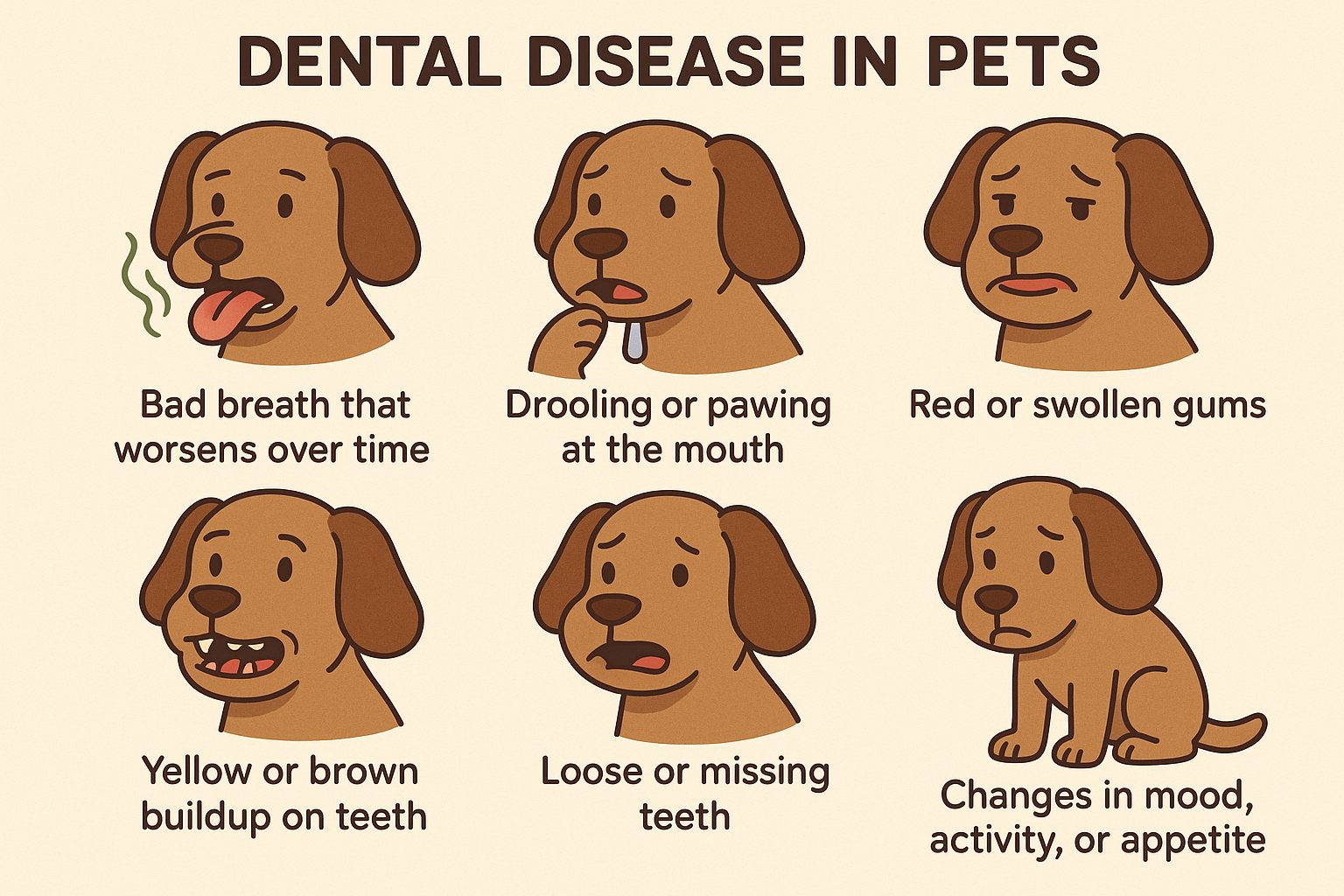A little bad breath might seem harmless, but when it comes to dogs and cats, it can be an early sign of dental disease. This condition, which includes gingivitis, periodontitis, and tooth decay, affects the vast majority of pets over the age of three. Left unchecked, it does not just impact the teeth. It can spread bacteria through the bloodstream and lead to heart, kidney, and liver complications.
The quiet nature of dental disease makes it especially concerning. Pets do not complain about mouth pain. Instead, they adapt, often hiding their discomfort until it reaches an advanced stage. By the time owners notice trouble, the damage is often already significant.
What causes dental disease in pets
Dental disease begins when food particles, saliva, and bacteria form plaque on the surface of the teeth. If this plaque is not removed regularly, it hardens into tartar, which creates a rough surface that allows even more bacteria to thrive. These bacteria trigger inflammation in the gums, leading to gingivitis and, over time, periodontitis, where the supporting structures of the tooth break down.
The most common causes include:
- Lack of regular brushing or dental care
- Soft food diets that stick to the teeth
- Breed-specific vulnerabilities, especially in small dogs and flat-faced cats
- Genetics and immune system issues that influence gum health
Signs to look for
Because pets often suffer in silence, early signs of dental disease can be easy to miss. Pay attention to:
- Bad breath that worsens over time
- Drooling or pawing at the mouth
- Red or swollen gums
- Yellow or brown buildup on teeth
- Loose or missing teeth
- Difficulty chewing or preference for soft food
- Changes in mood, activity, or appetite
These symptoms may appear slowly, which is why consistent observation is so important. As with many health issues, early action makes treatment less invasive and more effective.

Why oral health matters beyond the mouth
The impact of dental disease goes far beyond tooth loss. Bacteria from infected gums can enter the bloodstream, affecting organs like the heart, kidneys, and liver. This systemic inflammation contributes to a decline in overall health, especially in older animals or those already dealing with chronic conditions.
In many ways, poor oral health accelerates biological aging. It adds stress to the immune system and increases the body’s workload. Over time, even mild untreated infections can affect life expectancy and quality of life.
Prevention is protection
Preventing dental disease is more effective, less expensive, and far less painful than treating it once it is advanced. The most effective strategies include:
- Daily or frequent brushing using pet-safe toothpaste
- Routine dental cleanings performed by a veterinarian
- Dental chews and toys that reduce plaque buildup
- Diet considerations that promote chewing and saliva production
- Regular home inspections to check for redness, swelling, or buildup
When oral health declines alongside other conditions
In some cases, dental disease is only one part of a larger health decline. For aging pets or those with other chronic illnesses, infections and inflammation in the mouth can worsen existing vulnerabilities. When a pet reaches the point where procedures become risky or pain persists despite care, it may be time to consider more holistic questions about quality of life.
These are not easy conversations. They often involve weighing interventions against comfort, cost, and the emotional impact of continued treatment. In these moments, families begin to ask what other options might exist when today’s treatments no longer suffice.
Cryopreservation: planning beyond today’s limits
Cryopreservation offers a scientifically grounded option for individuals, including animals, who want to preserve the possibility of future treatment. When a pet reaches the end of available care, and decline becomes irreversible, cryopreservation allows for the preservation of biological structure after legal death at ultra-low temperatures.
It is not a cure, and it is not a shortcut. But it is a decision to preserve life’s potential beyond the constraints of today. At Tomorrow.bio, we offer cryopreservation for both humans and pets, helping families who want to explore options that might one day lead to reanimation and repair when future technologies allow.
We understand how overwhelming a diagnosis can be. Whether your companion is facing dental disease, another chronic condition, or a broader decline, we are here to walk you through how cryopreservation works, if and when you feel ready to consider it.
Closing thoughts
Dental disease in pets is common, but it is never minor. From discomfort to systemic illness, it can shape the way your pet lives, eats, and interacts. Staying ahead of it requires attention, compassion, and long-term planning.
And if the time comes when care options begin to narrow, it is worth knowing that other choices exist. At Tomorrow.bio, we believe no life should be limited by current capabilities alone. Whether you are treating symptoms today or planning for the future, we are here to support that journey with clarity, respect, and hope.
About Tomorrow.bio
At Tomorrow.bio we are dedicated to advancing the science of cryopreservation with the goal of giving people a second chance at life As Europe’s leading human cryopreservation provider we focus on rapid high-quality standby, stabilization and storage of terminal patients preserving them until future technologies may allow revival and treatment.
Our mission is to make human cryopreservation a reliable and accessible option for everyone We believe that no life should end because current capabilities fall short.
Our vision is a future where death is optional where people have the freedom to choose long-term preservation in the face of terminal illness or fatal injury and to awaken when science has caught upInterested in learning more or becoming a member
📧 Contact us at hello@tomorrow.bio
🌐 Visit our website www.tomorrow.bio
🤝 Schedule a call with our team Book a consultation



